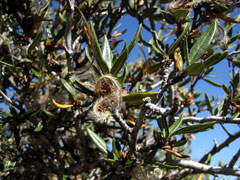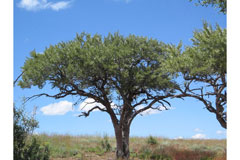 |
|
http://commons.wikimedia.org/wiki/User:Wsiegmund |
 |
| Sheri Hagwood @ USDA-NRCS PLANTS Database |
Translate this page:
Summary
Physical Characteristics

 Cercocarpus ledifolius is an evergreen Tree growing to 8 m (26ft 3in) at a slow rate.
Cercocarpus ledifolius is an evergreen Tree growing to 8 m (26ft 3in) at a slow rate.
See above for USDA hardiness. It is hardy to UK zone 6. It is in leaf all year. The species is hermaphrodite (has both male and female organs) and is pollinated by Insects.
It can fix Nitrogen.
Suitable for: light (sandy), medium (loamy) and heavy (clay) soils and prefers well-drained soil. Suitable pH: mildly acid, neutral and basic (mildly alkaline) soils. It cannot grow in the shade. It prefers dry or moist soil and can tolerate drought. The plant can tolerate maritime exposure.
UK Hardiness Map
US Hardiness Map
Synonyms
Plant Habitats
Woodland Garden Secondary; Sunny Edge;
Edible Uses
Edible Parts:
Edible Uses: Tea
The scraped bark makes a flavourful addition to a brew of Mormon tea (Ephedra spp.)[183].
References More on Edible Uses
Medicinal Uses
Plants For A Future can not take any responsibility for any adverse effects from the use of plants. Always seek advice from a professional before using a plant medicinally.
Cardiac Haemostatic Poultice Stomachic TB Tonic VD
Mountain mahogany was employed medicinally by a number of native North American Indian tribes who used it to treat a variety of complaints[257]. It is virtually not used in modern herbalism. The bark is antihaemorrhagic, cardiac, stomachic and tonic[257]. A decoction has been used in the treatment of coughs and colds, pneumonia, spitting up of blood, stomach aches, diarrhoea (including for children), tuberculosis and VD[257]. A poultice of the green powdered wood has been applied to sores, cuts, wounds and burns[257]. It has also been sprinkled on syphilitic sores[257]. An exudation from the plant has been dried, ground into a powder and applied to the ear to treat earaches[257].
References More on Medicinal Uses
The Bookshop: Edible Plant Books
Our Latest books on Perennial Plants For Food Forests and Permaculture Gardens in paperback or digital formats.

Edible Tropical Plants
Food Forest Plants for Hotter Conditions: 250+ Plants For Tropical Food Forests & Permaculture Gardens.
More

Edible Temperate Plants
Plants for Your Food Forest: 500 Plants for Temperate Food Forests & Permaculture Gardens.
More

More Books
PFAF have eight books available in paperback and digital formats. Browse the shop for more information.
Shop Now
Other Uses
Fodder Fuel Wood
A red dye is obtained from the inner bark[257]. The wood is extremely hard and so dense that it will not float in water[229]. It is also brittle[82]. It makes an excellent fuel, giving off intense heat whilst burning for a long time[229]. It is occasionally used in the manufacture of small articles for domestic and industrial use[82].
Special Uses
Carbon Farming Nitrogen Fixer
References More on Other Uses
Cultivation details
Agroforestry Services: Nitrogen Fodder: Bank Management: Standard Regional Crop
Requires a position in full sun in a perfectly draining soil[200]. Succeeds in dry soils. Tolerates maritime exposure[200]. Some forms of this species are hardy to about -17°c[200]. A slow-growing tree or large shrub, it is not a true evergreen, but its leaves persist over winter and do not fall until after the new leaves are growing[229]. Some members of this genus have a symbiotic relationship with certain soil micro-organisms, these form nodules on the roots of the plants and fix atmospheric nitrogen. Some of this nitrogen is utilized by the growing plant but some can also be used by other plants growing nearby[200].
Carbon Farming
-
Agroforestry Services: Nitrogen
Plants that contribute to nitrogen fixation include the legume family – Fabaceae.
-
Fodder: Bank
Fodder banks are plantings of high-quality fodder species. Their goal is to maintain healthy productive animals. They can be utilized all year, but are designed to bridge the forage scarcity of annual dry seasons. Fodder bank plants are usually trees or shrubs, and often legumes. The relatively deep roots of these woody perennials allow them to reach soil nutrients and moisture not available to grasses and herbaceous plants.
-
Management: Standard
Plants grow to their standard height. Harvest fruit, seeds, or other products. Non-Destructive management systems.
-
Regional Crop
These crops have been domesticated and cultivated regionally but have not been adopted elsewhere and are typically not traded globally, Examples in this broad category include perennial cottons and many nuts and staple fruits.
References Carbon Farming Information and Carbon Sequestration Information
Temperature Converter
Type a value in the Celsius field to convert the value to Fahrenheit:
Fahrenheit:
The PFAF Bookshop
Plants For A Future have a number of books available in paperback and digital form. Book titles include Edible Plants, Edible Perennials, Edible Trees,Edible Shrubs, Woodland Gardening, and Temperate Food Forest Plants. Our new book is Food Forest Plants For Hotter Conditions (Tropical and Sub-Tropical).
Shop Now
Plant Propagation
Seed - sow spring in a greenhouse. When they are large enough to handle, prick the seedlings out into individual pots and grow them on in a greenhouse for at least their first winter. Plant them out into their permanent positions in late spring or early summer, after the last expected frosts. Cuttings of half-ripe wood, July/August in a frame[200].
Other Names
If available other names are mentioned here
Native Range
NORTHERN AMERICA: United States (Colorado (west), Idaho, Montana (s. & w.), Oregon (east), Washington (southeast), Wyoming (west), Arizona, California, Nevada, Utah)
Weed Potential
Right plant wrong place. We are currently updating this section.
Please note that a plant may be invasive in one area but may not in your area so it's worth checking.
Conservation Status
IUCN Red List of Threatened Plants Status :

Growth: S = slow M = medium F = fast. Soil: L = light (sandy) M = medium H = heavy (clay). pH: A = acid N = neutral B = basic (alkaline). Shade: F = full shade S = semi-shade N = no shade. Moisture: D = dry M = Moist We = wet Wa = water.
Now available:
Food Forest Plants for Mediterranean Conditions
350+ Perennial Plants For Mediterranean and Drier Food Forests and Permaculture Gardens.
[Paperback and eBook]
This is the third in Plants For A Future's series of plant guides for food forests tailored to
specific climate zones. Following volumes on temperate and tropical ecosystems, this book focuses
on species suited to Mediterranean conditions—regions with hot, dry summers and cool, wet winters,
often facing the added challenge of climate change.
Read More
Expert comment
Author
Nutt. ex Torr.&A.Gray.
Botanical References
82200
Links / References
For a list of references used on this page please go here
Readers comment
| Add a comment |
|
If you have important information about this plant that may help other users please add a comment or link below. Only comments or links that are felt to be directly relevant to a plant will be included. If you think a comment/link or information contained on this page is inaccurate or misleading we would welcome your feedback at [email protected]. If you have questions about a plant please use the Forum on this website as we do not have the resources to answer questions ourselves.
* Please note: the comments by website users are not necessarily those held by PFAF and may give misleading or inaccurate information.
To leave a comment please Register or login here All comments need to be approved so will not appear immediately.
|
Subject : Cercocarpus ledifolius
|
|
|
|